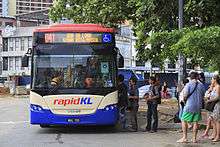Rapid KL (brand)
|
| |||
| Overview | |||
|---|---|---|---|
| Owner | Prasarana Malaysia | ||
| Locale | Klang Valley, Malaysia | ||
| Transit type | |||
| Number of lines | |||
| Number of stations |
| ||
| Daily ridership |
| ||
| Website |
myrapid | ||
| Operation | |||
| Began operation | 16 December 1995 | ||
| Operator(s) | Rapid Rail & Rapid Bus | ||
| Technical | |||
| System length |
| ||
| Track gauge | 1,435 mm (4 ft 8 1⁄2 in) | ||
| |||
Rapid KL (styled as rapidKL; ) is a service brand used by Prasarana Malaysia subsidiaries companies to refer the public transportation services dedicated for Kuala Lumpur and Klang Valley area. It is acronym for Rangkaian Pengangkutan Intergrasi Deras Kuala Lumpur. The service brand name used by Rapid Rail on LRT & monorail services and Rapid Bus on BRT & stage bus services.
History
Public transport restructuring
The need for Kuala Lumpur's public transport system to be revamped became apparent almost immediately after the LRT lines began commercial operations when their ridership was much lower than anticipated. This caused lower than expected revenue levels and the two LRT concessionaires, Sistem Transit Aliran Ringan Sdn Bhd (STAR-LRT) and Projek Usahasama Transit Ringan Automatik Sdn Bhd (PUTRA-LRT), could not repay their commercial loans. The financial crisis of 1997/1998 aggravated the situation. The two companies owed a total of RM5.7bil as at November 2001 when the government's Corporate Debt Restructuring Committee (CDRC) restructured the debts of the two LRT companies.
The bus service in Kuala Lumpur was also facing problems with lower ridership because of an increase in private car usage and lack of capital investments. The two new bus consortia which were formed in the mid 1990s to take over all bus services in Kuala Lumpur - Intrakota Komposit and Cityliner - began facing financial problems. Intrakota had reportedly accumulated losses amounting to RM450mil from the 1997/1998 financial crisis until SPNB took over in 2003.
With lower revenue, the bus operators could not maintain their fleets, much less invest in more buses. Frequencies and service deteriorated as buses began breaking down.
Public transport usage in the Klang Valley area dropped to about 16% of all total trips.
Improvement steps






Since taking over the LRTs and bus network, Prasarana has taken steps to improve their service.
- Increasing LRT capacity: Prasarana have issued tenders for the purchase of new LRT rolling stock to increase carrying capacity. Tender for 35 new train sets for the Kelana Jaya Line has been given out in October 2006 and October 2007. The trains are expected to be operational in September 2009. On 27 July 2009, Malaysian Prime Minister Najib Abdul Razak announced that the 35 new four-car trains will be operational by end-2012.[2]
- Boosting bus fleet: As most of the Rapid KL buses inherited were old and poorly maintained, one of its immediate concerns was to get more buses on the road. In 2005, the government promised 200 new Rapid KL buses.
- Increasing bus routes: Prasarana has put on several new routes to serve areas which never had bus services.
- Scheduled bus services: Rapid Bus introduced scheduled services for 16 Rapid Kl buses routes which are not heavily utilised. For the first time in Malaysia, expected bus arrival times and timetables were put up at bus stops along routes. However, these bus frequency timetables at the bus stops, as well as in myrapid website had been removed. This is because they could not cope with many sorts of problems, which is traffic congestion and insufficient number of buses, which resulted in late arrival of buses.
- Common monthly passes for both LRT and buses: This is the first time commuters have monthly passes which can be used on both LRTs and buses, helping to enhance integration of the public transport system.
- Common signage for all three LRT lines: The renaming of Putra-LRT and Star-LRT together with the changing of its signage will help enhance integration of the previously unconnected systems.
- Common Ticketing System Touch 'n Go can be used in all Rapid KL buses and rail lines
- Revamp of Rapid KL bus network: Prasarana scrapped the old Intrakota and Cityliner routes it inherited and introduced three types of bus services: City shuttles (BANDAR), trunk buses (UTAMA),, local shuttles (TEMPATAN), and express buses (EKSPRES). City shuttles will operate within Kuala Lumpur's central business district while trunk buses will link hubs at the edge of the CBD with suburban transportation hubs. At these suburban hubs, local shuttles will radiate out from rail-based public transport stations and fan out to residential areas. Express buses provide non-stop point-to-point route to specific destination.
Rapid KL service brand
Rail
Rapid KL service brand carried on three rail network. The entire rail network operated by Rapid Rail is 56 km long and has 60 stations.These trains can travel up to 60km/h .In 2008, these rail network carry a total of over 350,000 passengers daily.[3]
Bus
Rapid KL also used by Rapid Bus Sdn Bhd for the first bus rapid transit service in Malaysia and it is also one of the largest stage bus operators in the Klang Valley, next to Metrobus. Currently, there are 98 stage bus routes and 39 feeder bus services which operate from LRT stations. The bus routes operated by Rapid Bus were previously operated by Intrakota Komposit Sdn Bhd, a subsidiary of DRB-Hicom Bhd; and Cityliner Sdn Bhd, a subsidiary of Park May Bhd. In 2008, Rapid Bus carried around 390,000 passengers daily.[3]
References
- ↑ "Integrating ITS Technologies To Improve Efficiency, Reliability and Safety of Transport System" (PDF). prasarana. Retrieved 8 April 2014.
- ↑ Nik Anis & Dharmender Singh (28 July 2009). "Targets set for the six Key Result Areas". The Star.
- 1 2 "Penumpang Rapid KL naik mendadak". Utusan Malaysia. 9 July 2008. Retrieved 9 July 2008.